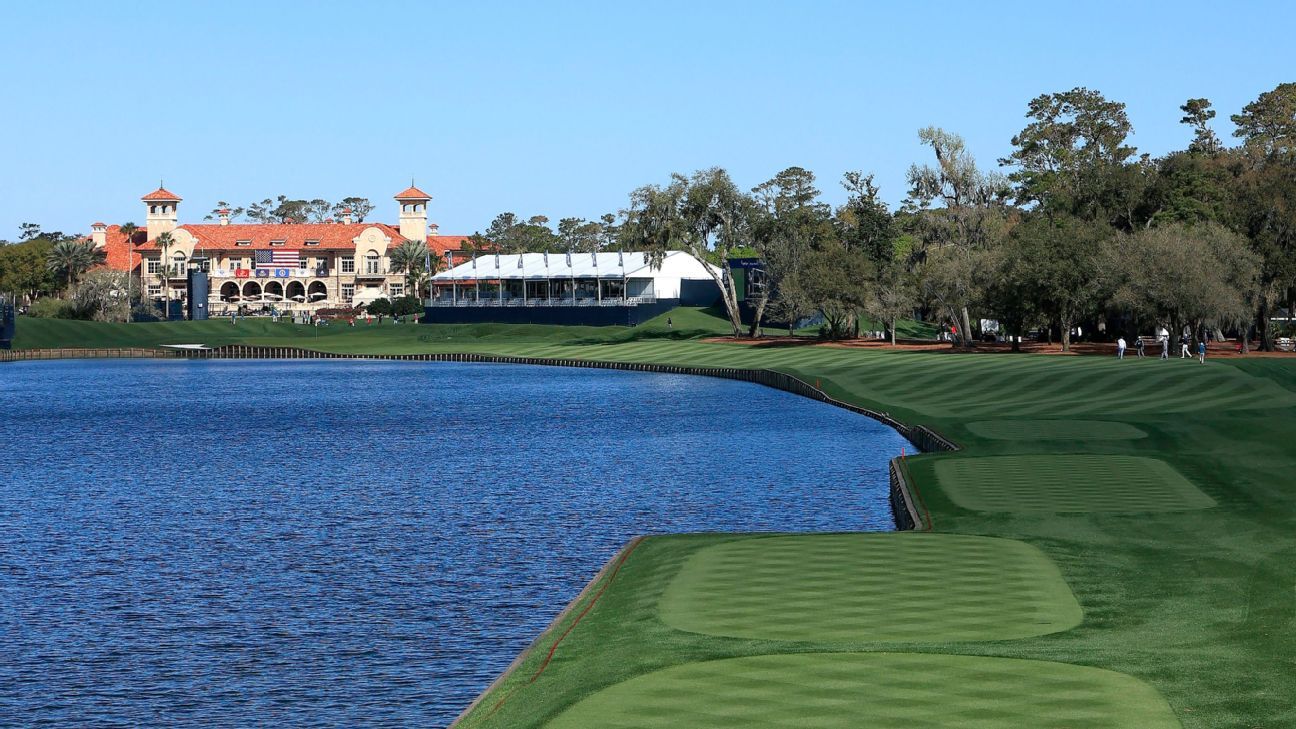
 Analytics Blog
Analytics Blog
March 8, 2022
2022 PLAYERS Championship
Where to miss around TPC Sawgrass
Previewing the 2022 PLAYERS Championship using shot-level data.
The 18th at TPC Sawgrass tempts players to bail right

En route to a dramatic victory at the 2015 PLAYERS Championship,
Rickie Fowler successfully challenged the water on the left side of the 18th hole at TPC Sawgrass five times
(4 in regulation, and once in the playoff).
Fowler hit all of these drives over 310 yards and in the fairway, allowing him to play the hole in a stress-free 1-under for the week.
The finisher at TPC Sawgrass is a great risk-reward hole. Take on the water down the left and pull it off? You are rewarded with a short iron into the green. But get a little tight and tug it left, the penalty is severe at about 1.75 strokes. For players looking to keep their heart rate down a bailout to the right is available, but that isn’t free: 0.55 strokes is the price of admission into the right rough and trees.
The 18th hole is the heightened version of a broader theme at TPC Sawgrass: missing fairways left is more penal than missing fairways right. Across all courses on the PGA Tour, Sawgrass has the 2nd highest differential between its average left-missed-fairway penalty and right-missed-fairway penalty. The table below breaks down each par 4/5 tee shot at TPC Sawgrass.
The finisher at TPC Sawgrass is a great risk-reward hole. Take on the water down the left and pull it off? You are rewarded with a short iron into the green. But get a little tight and tug it left, the penalty is severe at about 1.75 strokes. For players looking to keep their heart rate down a bailout to the right is available, but that isn’t free: 0.55 strokes is the price of admission into the right rough and trees.
The 18th hole is the heightened version of a broader theme at TPC Sawgrass: missing fairways left is more penal than missing fairways right. Across all courses on the PGA Tour, Sawgrass has the 2nd highest differential between its average left-missed-fairway penalty and right-missed-fairway penalty. The table below breaks down each par 4/5 tee shot at TPC Sawgrass.
Trouble Left!
Comparing left vs right misses at TPC Sawgrass
The missed-fairway penalty is calculated as the difference in hole score between drives that find the fairway and those that don’t.
The 9th is the only hole at TPC Sawgrass where left is a substantially better miss, and it has the widest fairway on the course.
If you were to miss every fairway left you would be expected to lose 2.6 strokes compared to missing every fairway right.
Given this information about TPC Sawgrass, a natural next step is to look at players' shot patterns off the tee. We are going to focus on three variables: a player’s average line relative to the target, the percentage of big right misses, and the percentage of big left misses. The “target” on a given hole is defined as the average location of tee shots that find the fairway (there will be cases where this method isn’t perfect, but overall it’s fine), and a “big miss” is defined as any tee shot that travels more than 30 yards left or right of this target.
While shot patterns are interesting on their own, we can add further context to this data. We classify holes on the PGA Tour into those which have a bailout left or right. More specifically, holes that have a penalty area left (that is actually in play) but no penalty area to the right are classified as holes where players can bail right. The opposite description applies to holes classified as ones with a bailout left. At TPC Sawgrass, holes 7, 10 (only in 2021 – lots of penalty strokes there last year for some reason), 12, 14, and 18 are classified as “trouble left, bailout right” holes, while only 5 and 9 are ‘trouble right, bailout left’ holes.
On all non-par 3 holes from 2018-2022, PGA Tour players missed left by 30 yards or more 4.9% of the time and missed right by 30 yards or more 5.1% of the time. With a bailout available to the right, the percentage of big right misses rose to 6.8% while the big left miss rate fell to 3.9%. On holes with trouble right and a bailout left, big right misses occurred 4.7% of the time and big left misses 6.8%. The next table summarizes this data for every player in the 2022 Players Championship field, as well as Phil Mickelson (an analysis like this can’t exclude Phil) and Rickie (honorary member of this week’s field).
Given this information about TPC Sawgrass, a natural next step is to look at players' shot patterns off the tee. We are going to focus on three variables: a player’s average line relative to the target, the percentage of big right misses, and the percentage of big left misses. The “target” on a given hole is defined as the average location of tee shots that find the fairway (there will be cases where this method isn’t perfect, but overall it’s fine), and a “big miss” is defined as any tee shot that travels more than 30 yards left or right of this target.
While shot patterns are interesting on their own, we can add further context to this data. We classify holes on the PGA Tour into those which have a bailout left or right. More specifically, holes that have a penalty area left (that is actually in play) but no penalty area to the right are classified as holes where players can bail right. The opposite description applies to holes classified as ones with a bailout left. At TPC Sawgrass, holes 7, 10 (only in 2021 – lots of penalty strokes there last year for some reason), 12, 14, and 18 are classified as “trouble left, bailout right” holes, while only 5 and 9 are ‘trouble right, bailout left’ holes.
On all non-par 3 holes from 2018-2022, PGA Tour players missed left by 30 yards or more 4.9% of the time and missed right by 30 yards or more 5.1% of the time. With a bailout available to the right, the percentage of big right misses rose to 6.8% while the big left miss rate fell to 3.9%. On holes with trouble right and a bailout left, big right misses occurred 4.7% of the time and big left misses 6.8%. The next table summarizes this data for every player in the 2022 Players Championship field, as well as Phil Mickelson (an analysis like this can’t exclude Phil) and Rickie (honorary member of this week’s field).
Fearing the Left Miss
Who bails right when trouble looms down the left side?
The first column is the player's average line relative to the target (e.g. Jimmy Walker's tee shots miss 3 yards right
of target on average). The final column tells us how much a golfer’s percentage of big right misses increases relative to their big left misses when there is a bailout right.
For example, across all holes Jimmy Walker, AKA "The Bailman", misses big right 5% more than he misses big left (11.2% vs 6.2%).
On holes with trouble left and a bailout right, Walker misses big right 11.8% more than he misses big left (16.2% vs 4.4%); this yields a “bail tendency” of 6.8%.
The table's columns are sortable, so click around!
Returning to Fowler, it’s interesting to place his performance on the 18th hole in 2015 in the broader context of his off-the-tee data (albeit from a different time period). From 2018-2022, Fowler hit 3,476 tee shots with an even miss distribution: his average line was 0.3 yards left of target, and his big left and big right misses were about equal at 5.3%. Restricting to holes with trouble left (568 shots), Rickie’s big right misses only went up slightly to 5.9%, while his big left misses fell to 5.1%. This gives Fowler the 115th lowest rank (of 146) in his tendency to bail right when the option is available.
So what does this all mean for predicting the 2022 PLAYERS? The first table highlighted the sizeable penalty for missing fairways in either direction at TPC Sawgrass, which fits with the fact that driving accuracy is an important predictor of success here. However, given the more severe penalties to left misses at Sawgrass, players who tend to avoid that left miss should be also be expected to overperform this week. The second table highlighted which players are more likely to challenge the hazards that line the left side of TPC Sawgrass. With Rickie Fowler notably absent from this year's edition of the PLAYERS, who will step up to fill his shoes?
Returning to Fowler, it’s interesting to place his performance on the 18th hole in 2015 in the broader context of his off-the-tee data (albeit from a different time period). From 2018-2022, Fowler hit 3,476 tee shots with an even miss distribution: his average line was 0.3 yards left of target, and his big left and big right misses were about equal at 5.3%. Restricting to holes with trouble left (568 shots), Rickie’s big right misses only went up slightly to 5.9%, while his big left misses fell to 5.1%. This gives Fowler the 115th lowest rank (of 146) in his tendency to bail right when the option is available.
So what does this all mean for predicting the 2022 PLAYERS? The first table highlighted the sizeable penalty for missing fairways in either direction at TPC Sawgrass, which fits with the fact that driving accuracy is an important predictor of success here. However, given the more severe penalties to left misses at Sawgrass, players who tend to avoid that left miss should be also be expected to overperform this week. The second table highlighted which players are more likely to challenge the hazards that line the left side of TPC Sawgrass. With Rickie Fowler notably absent from this year's edition of the PLAYERS, who will step up to fill his shoes?